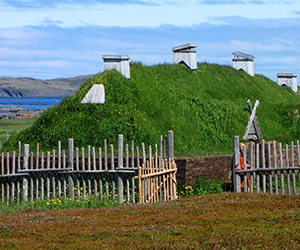CANADA HISTORY - War
13 Colonies - Quebec City

The American Revolution started with "the shot heard around the world" at Concord but quickly spread to include Canada when American revolutionary forces invaded Quebec. The invasion lead by Montgomery and Arnold came close to succeeding and would have led to the inclusion of all British North American colonies in the revolution. Quebec was saved and with it the other Northern Colonies. Halifax became the main naval base for the duration of the war. The results of the Quebec campaign prevented the forces of Manifest Destiny from taking all of North America for the new nation which the founding fathers in the United States had delivered.
The notion among many in the revolutionary ranks was that the subjugated French Canadians would welcome the invading Americans as liberator and would join in the resistance against the British. The reality was a little different.
With the festering of politic agendas in the 13 colonies coming to a head with the meeting of the Continental Congress in Philadelphia, those delegates naturally looked to the absent British American colonies such as Quebec, Nova Scotia, and other potential allies. The Continental Congress must have felt that to bring these additional colonies into the revolutionary circle would not only increase their voice in England, increase resources to draw upon and hence chances of success, but would also take away potential bases of support and attack that the British could use against the member colonies of the revolution. A large British naval base existed at Halifax in Nova Scotia and Quebec City, and as in the time of the 7 years war, were looked upon as a dagger pointed at heart of New England and the mid-Atlantic colonies.
Washington was appointed the commander of the continental army in the autumn of 1775 and was ordered to turn this group of state militia's and other volunteers into a real army. One of the first decisions that Washington and the Continental Congress made was that Quebec needed to be brought into the revolution as allies. It was felt that the French Canadians would be more then willing to break away from Britain and either join the other colonies or establish it's independence. Om June 27, 1775 the decision was made to send an army of liberation to Quebec to force the British out.
The attack was to be a double pronged approach with Richard Montgomery leading a force from New York to take Montreal and Benedict Arnold taking his canoe army up along the river routes to Quebec City. Arnold departed Massachusetts on September 13th and heading into the wilderness towards Quebec. Montgomery also so out and by November 2nd had taken St Johns.
When Montgomery arrived at Montreal he attacked and occupied the city on November 13th. The British commander General Carleton had abandoned the city and set out for Quebec City with his army. Arnold had arrived at Quebec City on November 8th but decided to wait for Montgomery and his army before attacking. When Montgomery arrived on December 5th, the Americans started a siege of Quebec and demanded that Carleton surrender which he refused to do. Time was against the Americans due to expiration of most of their soldiers enlistments on January 1, 1776. They attacked on December 27th and nearly took the city but were rebuffed. They decided to gamble all on an all out attack on December 31st, the night before their army might well dissolve with ending enlistments. A terrible snowstorm hit Quebec City on December 30th but they decided to proceed with the attack anyway.
The attack began a 2 in the morning of December 31st when Montgomery brought his 300 troops around to the west side of the city and Arnold prepared his 600 soldiers to attack form the eats side. They had planned to charge into the lower area of the city and then make their way through the streets and to the upper area where they could force Carleton out of the city or defeat him in detail. Carleton however, had been informed by an American deserted that the attack was coming and quickly rushed his men down to the lower part of the city and threw up a defensive barrier to meet Montgomery and planned an ambush on the east side to rebuff Arnold.
When Montgomery's men reached the barrier on the west side, the English opened fire with rifles and one canon. They killed three men immediately, including Montgomery, and the rest fled in panic and did not return. Arnold men attacked from the eats but Arnold was wounded almost immediately. Captain Morgan took the command of the rest of Arnold's men and they rushed through the lower city brushing aside all resistance. They then stopped before finishing Carleton's men off to wait for Montgomery, He did not come and by morning they decided to finish the attack without him. Carleton had used the precious time to bring more men into the lower town and they had re-occupied the barriers and taken positions in many of the buildings throughout the area. When Morgan started the final push he and his men found that they were being shot at form almost every house, angle and hidden position. They were slowly killed or captured and finally Morgan capitulated the remnants of his force.
Arnold managed to escape and collect the remains of the American troops and tried to continue the siege. He was eventually forced to retreat to Montreal and in May when British General Burgoyne arrived with over 4,000 soldiers, Arnold began the retreat from Canada. The Americans would not invade or threaten Canada again during the war.
Cite Article : Reference: www.canadahistory.com/sections/documents/documents.html
Source: NA



